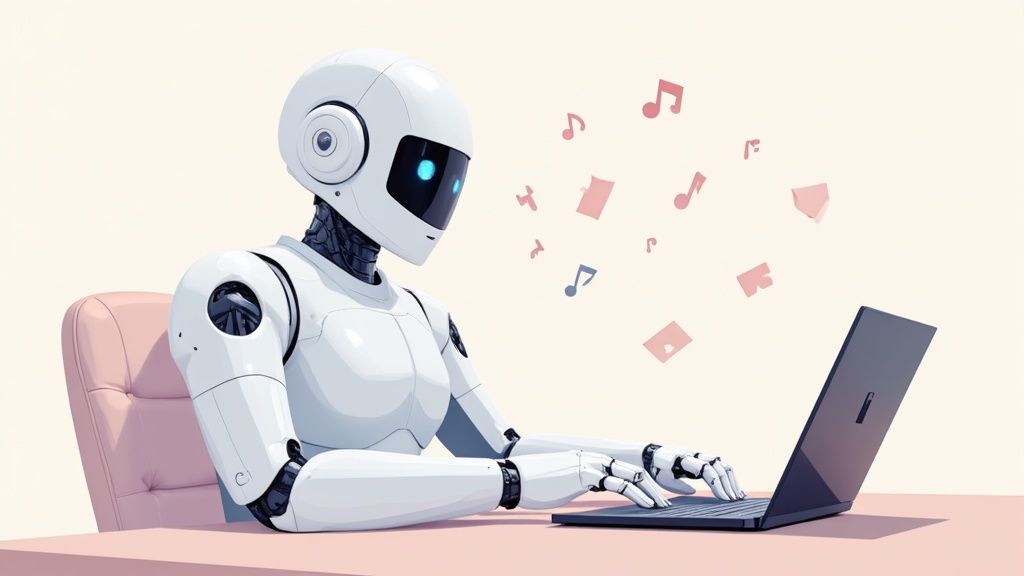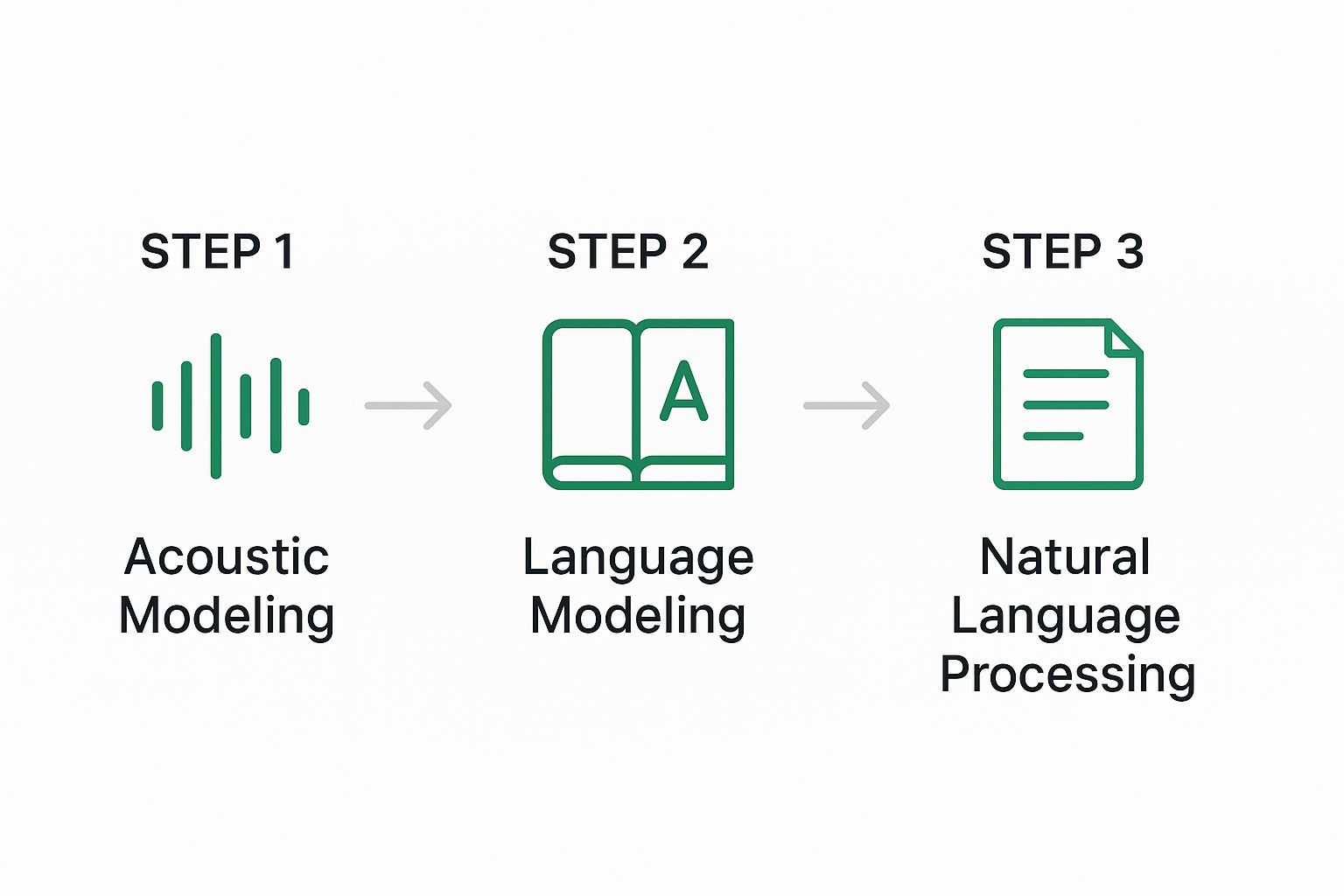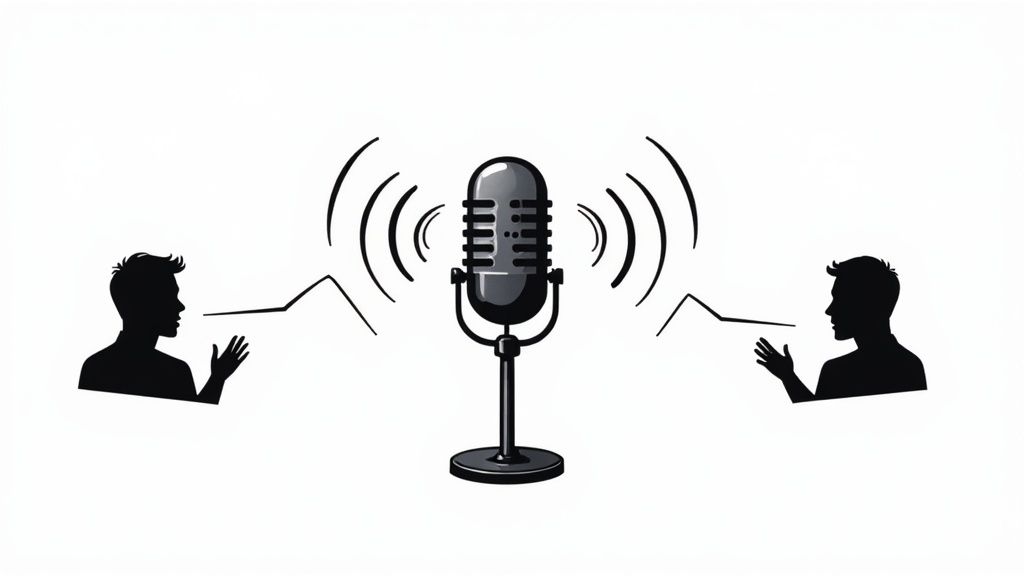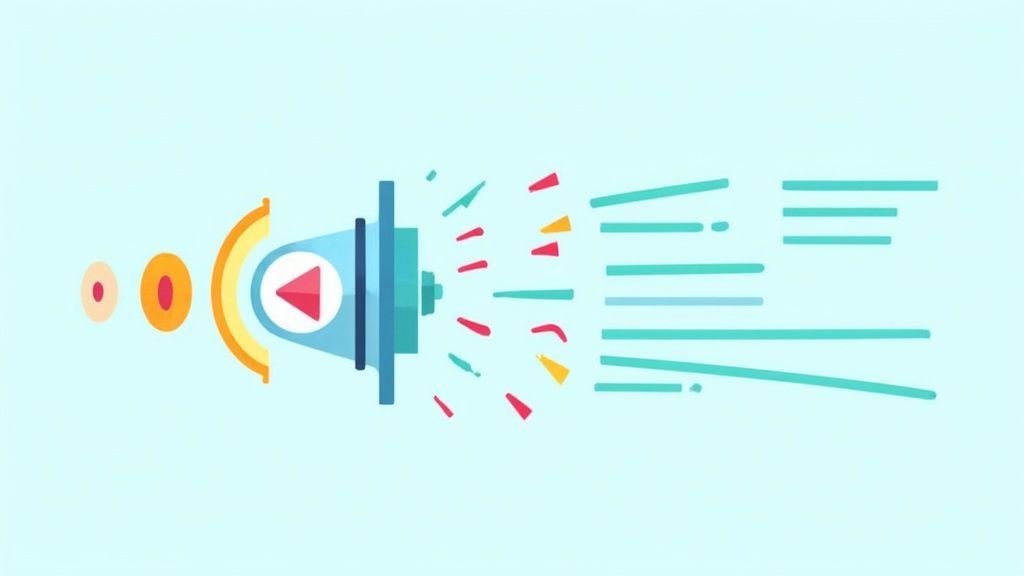So, what exactly is audio-to-text AI? In simple terms, it's tech that listens to people talking and writes down what they say. It's like having a super-fast typist on call 24/7 who can deal with different accents and spit out a full transcript in minutes. Think of it as your personal assistant for turning any chat into a written record.
Your Super-Fast Digital Scribe

Let's skip the complicated tech talk. Basically, these AI models get trained on a massive library of human speech—we're talking thousands and thousands of hours of audio. This intense training teaches the AI to pick up on the subtle patterns, sounds, and context of language, kind of like how a kid learns to understand what people are saying.
The AI doesn't just "hear" a bunch of sounds. It breaks speech down into its tiniest parts, called phonemes, and then cleverly puts them back together to make words. From there, some fancy algorithms figure out how to arrange those words into sentences that actually make sense, punctuation and all. It’s not just listening; it’s actually trying to get the meaning behind the sounds.
Why This Tech Is a Game-Changer
The real magic here is making spoken information searchable. Before this stuff was common, finding a specific point in a two-hour meeting recording meant endlessly dragging the playhead back and forth. It was a total pain. Now, you can just open the transcript, hit CTRL+F, and find exactly what you’re looking for in seconds.
This one simple thing opens up a whole new world for pretty much everyone.
- For Content Creators: Instantly turn a podcast or video interview into a blog post, detailed show notes, or a dozen social media captions.
- For Students: Get perfect, word-for-word lecture notes without typing like a maniac, making it way easier to study and review key concepts.
- For Professionals: Build a searchable archive of every meeting, client call, and brainstorming session. No great idea ever has to get lost in the shuffle again.
The goal isn't just to get words on a page; it's to turn messy audio data into a valuable, organized, and super-accessible asset. This is a huge shift in how we deal with information.
This whole process of turning speech into text is a key step in how AI makes sense of the world, often mixing audio with other types of info. To get a better feel for how AI combines things like audio and images, you can learn more about what is multimodal learning in our detailed guide. By turning our spoken words into a format that computers can actually analyze, we unlock a whole new level of insight and automation.
How AI Turns Your Voice into Words
So, what's actually going on behind the scenes when you click that "transcribe" button? It might feel like magic, but it’s really just a smart, step-by-step process. Think of it like teaching a computer a new language from the ground up—it’s not just about hearing sounds, but actually understanding them in context.
The whole thing starts with the AI needing to hear you clearly. Just like a person in a noisy room, it has to work to separate your voice from background chatter, the hum of an AC unit, or a passing siren. That's the first big challenge.
The Three Core Steps of AI Transcription
First, the AI jumps into Acoustic Modeling. This is where it listens to the raw audio and chops it up into the smallest units of sound, called phonemes. It’s basically the digital version of telling a 'p' sound from a 'b' sound—a super important first filter for making sense of the noise.
Next up is Language Modeling. After figuring out those tiny sounds, the AI acts like a super-powered dictionary and grammar guide. It matches those sound combos to actual words it has learned from looking at billions of sentences. This is the part where it figures out that the sounds "h-e-l-l-o" are almost definitely the word "hello."
Finally, the AI uses Natural Language Processing (NLP) to put all the puzzle pieces together. It doesn't just throw out a random list of words; it carefully arranges them into grammatically correct sentences that actually make sense. This is how it knows to write "How are you doing?" instead of a jumbled mess like "You how doing are?"
This infographic breaks down how an audio to text AI turns sound waves into structured, readable sentences.

As you can see, each stage cleverly builds on the last, turning raw audio into meaningful text, one step at a time.
The real breakthrough isn't just recognizing single words; it's the AI's knack for getting the context and grammar right to build sentences that sound like a human wrote them.
The demand for this tech is totally blowing up. The global speech-to-text API market was valued at USD 4,423.2 million in 2025 and is projected to nearly double to USD 8,569.5 million by 2030, according to Grand View Research. This crazy growth just goes to show how essential automated transcription has become for all sorts of industries.
This whole process of transcribing and understanding audio is also the building block for creating other kinds of content. For instance, a YouTube AI summary tool uses these same ideas to pull out the key info from a long video and give you the highlights in seconds.
Manual Transcription vs Audio to Text AI
When you put this automated process up against the old-school way of doing things, the difference is night and day. A side-by-side look really shows off the efficiency boost.
| Feature | Manual Transcription | Audio to Text AI |
|---|---|---|
| Speed | Takes 4-5 hours per hour of audio | Takes just a few minutes |
| Cost | Usually $1-2 per audio minute | Often pennies per minute or less |
| Scalability | Limited by how many people are available | Instantly scalable for huge amounts of audio |
| Turnaround | Hours or even days | Pretty much instant |
At the end of the day, while human transcribers still have a place for really tricky or sensitive stuff, AI has completely changed the game for everyday transcription, making it faster, cheaper, and easier to get your hands on than ever before.
Everyday Wins with AI Transcription
So, an audio to text AI can turn spoken words into written ones—cool, but what does that actually do for you? The real magic isn't just getting the words down; it's about what you can do once they're in a format you can actually use. It all comes down to getting back your most valuable resource: time.
Think about it: a one-hour recording can easily take a pro typist 4-5 hours to transcribe by hand. Instead of being glued to your keyboard, hitting pause and rewind over and over, you can have a full transcript ready in minutes. AI does the heavy lifting faster than you can make a cup of coffee.
Supercharging Productivity and Accessibility
This efficiency totally changes how you tackle your work. A marketer can stop scribbling frantic notes during a customer interview and actually listen, knowing a searchable transcript is on its way. Later, they can pull out key quotes and pain points without missing a thing.
It's also a huge deal for accessibility. When content creators offer up transcripts for their podcasts, videos, and webinars, they instantly open their work to people who are deaf or hard of hearing. It's a simple way to make information more inclusive and make sure your message reaches a much bigger audience.
The main benefit is simple: turning spoken conversations from fleeting moments into permanent, searchable, and shareable assets. All of a sudden, every word has lasting value.
This shift from audio to text is just one piece of the puzzle in making content more flexible. The reverse is also true—text can easily become audio. To see the other side of this coin, check out our guide on how to easily convert a PDF to audio for on-the-go learning.
Unlocking Hidden Insights
Beyond just saving time, AI transcription helps you find insights that were previously buried in audio files. Imagine a student who records all their lectures. Instead of scrubbing through hours of audio to find a specific topic for an exam, they can just search the transcript for a keyword and jump right to it.
This ability to quickly analyze spoken data is incredibly powerful in all sorts of fields. Here are just a few examples:
- Podcasters: Can instantly generate show notes, pull quotes for social media, or even write a full blog post based on an episode's transcript.
- Researchers: Have a much easier time combing through dozens of interviews to spot common themes and find the perfect supporting quotes.
- Legal Teams: Can create accurate, searchable records of depositions and client meetings without shelling out for expensive manual services.
In all these cases, the audio to text AI acts like a bridge. It connects the free-flowing, messy world of human speech to the organized, analytical world of data, helping you work a whole lot smarter.
Who's Actually Using Audio-to-Text AI?
It’s easy to think of audio-to-text AI as some fancy tool only used by big-shot tech companies, but the reality is way more interesting. This tech has quietly worked its way into a ton of different jobs, helping people in fields you wouldn't expect solve real, everyday problems. We're talking about a major shift in how pros capture and work with information.
From hospitals to courtrooms and creative studios, the uses are all over the place. The common theme? A big need to turn spoken words into accurate, searchable, and useful text—and to do it fast.
Making a Real-World Impact
Take the healthcare industry, where every minute counts and getting things right is crucial. Doctors are always documenting patient visits and updating records. Instead of spending hours typing up notes after a long shift, many are now using AI transcription to dictate their findings as they go.
They can just speak their observations into a recorder, and the AI creates a clean text record ready to be popped into a patient's file. This isn't just about saving time; it's about cutting down on burnout from paperwork and giving doctors more time to focus on what really matters: their patients.
It's not some futuristic idea anymore. This is a hands-on tool that helps people get back to the heart of their work by automating the boring parts.
The legal world has seen a similar change. Lawyers and paralegals are buried in spoken evidence, from long witness depositions to client interviews. Transcribing these recordings by hand is a slow, tedious, and pricey job. With an AI tool, a legal team can get a searchable transcript of a two-hour deposition in minutes, letting them find key statements and build their cases way more efficiently.
A Creator's Secret Weapon
For anyone who makes content, this tech has been a total game-changer. Podcasters, YouTubers, and marketers are using audio-to-text AI to squeeze way more value out of every single recording they make.
Imagine you've just finished an awesome one-hour podcast interview. In just a few minutes, an AI tool can help you:
- Generate a full transcript to publish as a blog post, which is great for SEO and making your content accessible.
- Pull out killer quotes to turn into eye-catching graphics for social media.
- Repurpose the whole conversation into a deep-dive article or a series of newsletter emails.
- Create accurate subtitles and captions for video clips, which is a must-have for engagement on platforms like Instagram and TikTok.
Suddenly, one piece of audio becomes a dozen different assets. It’s the definition of working smarter, not harder, helping you stretch the reach and impact of your content without a mountain of extra work.
The momentum is building in pretty much every industry. For instance, in March 2025, HealthArc integrated AI with electronic medical records to fully automate clinical documentation—a huge leap forward in a field where there's no room for error. This is just one of many stories showing how AI transcription is saving time and money while unlocking better data and accessibility for everyone. You can learn more about the growing role of AI transcription in various industries to see just how widespread this shift has become.
Tips for Getting a Flawless AI Transcript

While today's audio to text AI is seriously impressive, it's not magic. The old tech saying "garbage in, garbage out" is 100% true here. Without a doubt, the single biggest thing that affects how clean your transcript is is the quality of your original audio.
Think of it like this: you're giving the AI a clear road to follow. The cleaner your audio, the fewer potholes and detours it has to deal with. That means you get a much faster, more accurate result. The good news? You don’t need a fancy recording studio to make a huge difference.
Your Pre-Recording Checklist
Just running through a quick checklist before you hit record can save you a ton of editing headaches later. A few simple habits will help any AI tool do its best work for you.
- Get Closer to the Mic: You don't need fancy gear. Even the mic on your smartphone works surprisingly well if you keep it close. The key is to make sure your voice is the loudest, clearest sound the mic is picking up.
- Find a Quiet Space: Background noise is the enemy of accuracy. Simple fixes—like turning off a noisy fan, closing a window to block traffic, or just moving away from a humming fridge—can dramatically improve your audio.
- Speak Clearly and Naturally: You don’t have to talk like a robot. Just focus on saying your words clearly and speaking at a normal, conversational speed. Try not to mumble or rush through your sentences.
Your goal is to make the speaker's voice as crisp and clear as possible. Every little tweak you make before recording pays off with a much more accurate transcript on the other end.
Managing Multiple Speakers
Things get a bit trickier when you have more than one person talking. The AI now has the extra job of figuring out who's talking and when, which can get messy if people are talking over each other.
To get the best results from a group recording, try to get everyone to avoid interrupting or speaking at the same time. If you can, having each person use their own microphone—even the basic one on their earbuds—gives the AI much cleaner, separate audio tracks to work with. These small steps help the audio to text AI create a transcript that’s not just accurate, but also way easier to read.
Got Questions About Audio-to-Text AI? We’ve Got Answers.
It's totally normal to have a few questions before you dive in. Let's tackle some of the most common things people wonder about how audio-to-text AI actually works in the real world.
Just How Accurate Is It, Really?
This is the big one, right? Modern AI transcription can be incredibly on-point, often hitting 95% accuracy or even better.
But here’s the real talk: it all boils down to your audio quality. If you have a clean recording of one person speaking clearly into a decent mic, the results will be nearly perfect. But if you throw it a noisy recording from a crowded cafe with a bunch of people interrupting each other, you'll definitely have some cleanup to do.
Is It Safe to Upload My Audio to These Tools?
A totally fair question. Good services know that your data is sensitive and build their platforms with security as a top priority. The best providers use strong encryption to protect your files, both when you're uploading them and while they're sitting on their servers.
My advice? Always take a minute to check the privacy policy of any tool you’re thinking about using, especially if you're dealing with confidential stuff. You want a service that’s upfront and clear about how they handle and protect your info.
Can AI Handle Different Languages and Accents?
You bet, and this is where the tech has made some massive leaps. The top AI models are trained on huge, diverse sets of global audio, which means they can understand dozens of languages and a whole range of accents.
Of course, a very strong or unique accent might still trip up the AI every now and then. But these systems are always learning. The more exposure they get to all the different ways we speak, the better they get.
Ready to turn your own content into engaging audio? With podcast-generator.ai, you can transform articles, blog posts, and reports into studio-quality podcasts in minutes. No mic, no recording, just upload your content and let our AI do the rest. Create your first episode for free today.
